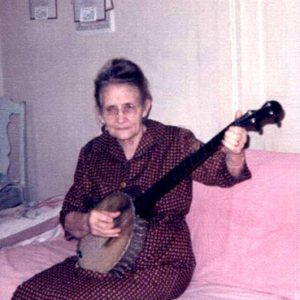calsfoundation@cals.org
Ollie Eva Woody Gilbert (1892–1980)
Both a local and national celebrity, Ollie Eva Woody Gilbert, known popularly as Aunt Ollie, performed with Jimmy Driftwood, Woody Guthrie, and many other folk musicians who have come to define the voice of the Great Depression. Venues ranged from friends’ and family members’ front porches and living rooms in the Ozark Mountains to Cow Palace in San Francisco, California; the Grand Ole Opry in Nashville, Tennessee; and Madison Square Garden in New York City.
The eighth of thirteen children of James (Jim) Franklin Woody and Mary Minerva Balentine Woody, Ollie Eva Woody was born on October 17, 1892, in the Hickory Grove area of Stone County. Shelearned to play the banjo at the age of five. Her instrument was made from a garden gourd with a squirrel hide stretched over it, and it had horsehair strings.The stories her mother told about the Civil War and the family’s move from Tennessee to settle in Arkansas greatly influenced her life and her music.
On July 29, 1909, just a few months before her sixteenth birthday, she married twenty-four-year-old Eual Oscar Gilbert. They had eight children. Her husband not only was a banjo picker himself but was known for his beautiful singing voice. Together, they played at parties, church gatherings, and other social occasions.
Ollie Gilbert was recorded by noted folklorist and musicologist Alan Lomax when he made his “Southern Journey” in 1959–1960, and appeared in his collection when it was released by Prestige Records in the early 1960s. She recordedmore than 400 songs for Max Hunter. Folklorist John Quincy Wolf recorded her multiple times, including her performances at the Arkansas Folk Festival in 1963 and 1964. She was an early member of the Rackensack Folklore Society and sang on volume one of The Rackensack (Rimrock, 1972) and later volumes released by the society.
She performed across the state and nation, including at three separate concerts given at the University of California at Los Angeles Folk Festival on May 14–16, 1965, as well as the Festival of American Folklife on July 1–5, 1970, at the National Mall in Washington DC. In 1972, she was recorded on the album Music of the Ozarks: A Sounds of the World Recording (National Geographic Society, 1972). In 1977, she appeared in All You Need Is Love: The Story of Popular Music, a seventeen-part television documentary series first broadcast in 1976, as well as on the Alan Lomax album The Gospel Ship (New World Records, 1977).
Gilbert continued performing, especially at the Arkansas Folk Festival, up until her death on September 17, 1980. She and her husband are buried at Timbo Cemetery.
For additional information:
Blevins, Brooks. Hill Folks: A History of Arkansas Ozarkers and Their Image. Chapel Hill: University of North Carolina Press, 2002.
Cochran, Robert. Our Own Sweet Sounds: A Celebration of Popular Music in Arkansas. 2nd ed. Fayetteville: University of Arkansas Press, 2005.
John Quincy Wolf Jr. Collection. Regional Studies Center. Lyon College, Batesville, Arkansas. Online at https://home.lyon.edu/wolfcollection/ (accessed February 28, 2025).
Max D. Hunter Collection of Ozark Folksongs, 1956–1976. Springfield-Greene County Library, Springfield, Missouri. Online at http://maxhunter.missouristate.edu/ (accessed February 28, 2025).
Shoudel, Pearl W. Some Remarkable Women of Arkansas. Little Rock: Arkansas IWY Co-ordinating Committee, 1977.
Freda Cruse Hardison
Mountain View, Arkansas

 Ollie Gilbert
Ollie Gilbert 



Comments
No comments on this entry yet.